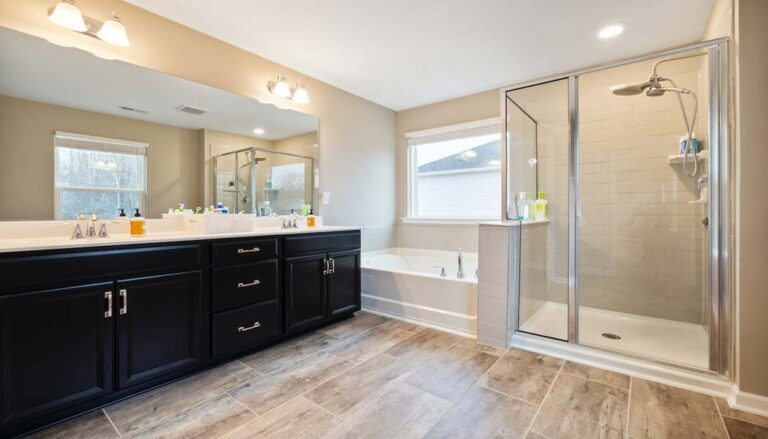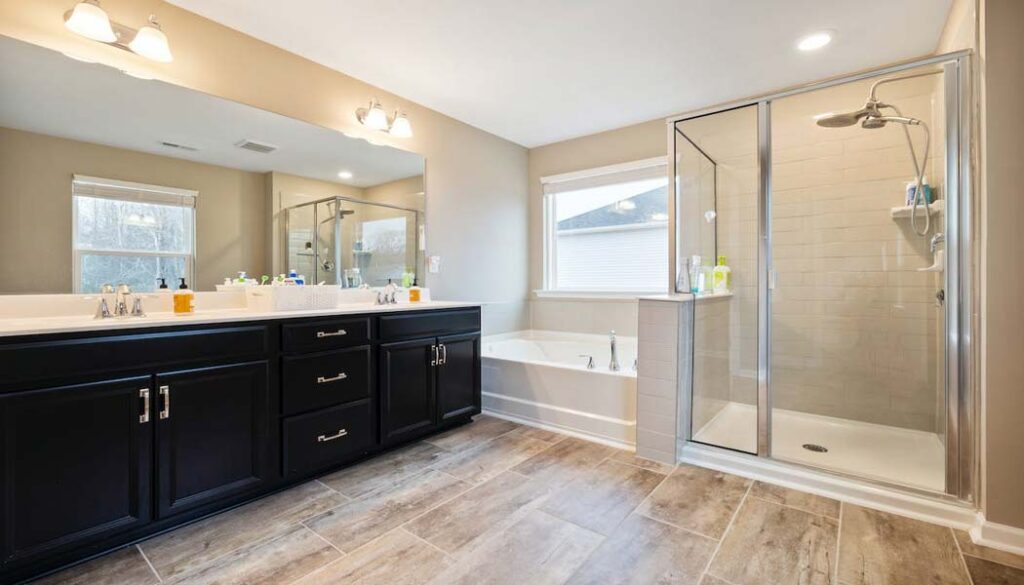
How to Paint Bathroom Cabinets That Are Not Wood?
Are your bathroom cabinets looking worn out and outdated? While wooden cabinets can be easily painted, what about cabinets made of other materials?
When it comes to repainting your non-wooden bathroom cabinets, the first thing that can come into your head is how to paint bathroom cabinets that are not wood.
To paint bathroom cabinets that are not wood, start by cleaning and sanding the surface. Apply a coat of primer, and then follow up with two coats of paint. Allow each coat to dry completely before applying the next one. Use a high-quality brush or roller for best results.

In this article, we’ll explore some tips and tricks for painting bathroom cabinets that are not made of wood. So, let’s get started!
Can You Paint Cabinets That Are Not Wood?
Yes, you can paint cabinets that are not made of wood, such as those made of laminate, metal, or MDF (medium-density fiberboard). The process of painting these types of cabinets is similar to painting wooden cabinets, but there are a few differences to keep in mind.
First, it’s important to clean the surface thoroughly and sand it lightly before applying any paint or primer. This will help the paint adhere better to the surface. Additionally, it’s important to choose a primer and paint that are appropriate for the cabinet material. For example, if you’re painting metal cabinets, you’ll need a primer and paint that are formulated for use on metal surfaces.
Just be sure to follow the manufacturer’s instructions for any products you use and allow each coat of paint or primer to dry completely before applying the next one.
How to Paint Bathroom Cabinets That Are Not Wood?
With the right preparation and tools, you can transform your bathroom cabinets and give them a fresh new look. Take a look at our step-by-step instructions for painting bathroom cabinets that are not wood:
Materials you’ll need:
- Cleaning solution (e.g. TSP, vinegar)
- Sandpaper (120-220 grit)
- Primer (appropriate for the cabinet material)
- Paint (appropriate for the cabinet material)
- Paintbrush or roller
- Painter’s tape
- Drop cloths
Step 1: Clean the cabinets thoroughly
Remove all items from the cabinets and clean them using a cleaning solution such as TSP or vinegar. Use a sponge or cloth to wipe the cabinets, then rinse with water and allow to dry completely.
Step 2: Sand the cabinets
Lightly sand the cabinets with sandpaper (120-220 grit). This will help the primer adhere better to the surface. Wipe off any sanding dust with a damp cloth and allow to dry.
Step 3: Apply painter’s tape
Use painter’s tape to protect any areas you don’t want to be painted, such as the walls or countertop.
Step 4: Apply the primer
Apply a coat of primer that is appropriate for the cabinet material. Allow the primer to dry completely, following the manufacturer’s instructions.
Step 5: Paint the cabinets
Apply two coats of paint that are appropriate for the cabinet material, allowing each coat to dry completely before applying the next one. Use a high-quality brush or roller for the best results.
Step 6: Remove painter’s tape and clean up
Once the final coat is dry, remove the painter’s tape and clean up any drips or mistakes. Allow the cabinets to dry completely before replacing any items.
What Paint is Best for Non Wood Cabinets?
The best paint for non-wood cabinets will depend on the material of the cabinets. Here are some recommendations:
Laminate Cabinets:
High-quality acrylic latex paint or a paint that’s specifically designed for use on laminate surfaces will work well. Look for a paint that has good adhesion properties and is durable enough to withstand regular cleaning.
Metal Cabinets:
Choose a paint that’s specifically designed for use on metal surfaces, such as an oil-based enamel or a high-quality acrylic paint. These paints are formulated to adhere well to metal and will provide a durable finish.
MDF Cabinets:
A high-quality water-based paint or a paint that’s specifically designed for use on MDF surfaces will work well. Look for a paint that’s formulated to resist chipping, cracking, and peeling.
In general, it’s important to choose a paint that’s appropriate for the cabinet material and provides good adhesion and durability. Be sure to follow the manufacturer’s instructions for any paint or primer you use, and allow each coat to dry completely before applying the next one.
What Kind of Paint do You Use on Bathroom Cabinets?
When painting bathroom cabinets, it’s important to choose a paint that is durable, moisture-resistant, and can withstand regular cleaning. Here are some paint options to consider:
Acrylic Latex Paint:
This type of paint is a good choice for bathroom cabinets because it’s durable, easy to clean, and resists mildew and moisture.
Enamel Paint:
Oil-based enamel paint is another option for bathroom cabinets, as it provides a durable and moisture-resistant finish.
Cabinet-specific Paint:
Many paint manufacturers offer paints that are specifically designed for use on cabinets. These paints often contain additives that make them more durable and moisture-resistant than regular paint.
When selecting paint, be sure to choose one that is appropriate for the cabinet material and finish, and follow the manufacturer’s instructions for application and drying times.
Do You Need Primer to Paint Bathroom Cabinets?
Yes, it’s highly recommended to use a primer when painting bathroom cabinets. A primer will help the paint adhere better to the surface, provide a uniform base coat, and can also help cover any stains or imperfections.
Additionally, a primer can help prevent the paint from chipping or peeling over time. It’s important to choose a primer that is appropriate for the cabinet material, such as a primer that’s specifically designed for use on non-wood surfaces. Be sure to follow the manufacturer’s instructions for application and drying times.
Is It Better to Spray or Paint Cabinets?
Both spraying and painting cabinets can result in a beautiful and long-lasting finish, but there are some differences to consider.
Spraying cabinets typically produces a smoother finish with no brush marks or roller stipple. It can also be faster and more efficient than painting with a brush or roller. However, it can be more difficult to control overspray and achieve an even coat.
Painting cabinets with a brush or roller can be more time-consuming, but it allows for more control over the application process and can be easier to touch up or fix mistakes.
Ultimately, the best method for painting or spraying cabinets will depend on personal preference, the size of the project, and the materials being used.
Can You Reface Non Wood Cabinets?
Yes, you can reface non-wood cabinets, such as those made of laminate, MDF, or metal. Refacing involves applying a new layer of material over the existing cabinets, such as a wood veneer or laminate sheets, and replacing the doors and hardware.
This can be a cost-effective way to update the look of your cabinets without the expense and hassle of a full replacement. It’s important to work with a professional refacing company or contractor who has experience with the specific materials you have, to ensure a quality result.
Final Words
Painting bathroom cabinets that are not made of wood, such as those made of laminate, MDF, or metal, can be a simple and cost-effective way to update the look of your bathroom. It’s important to choose a paint that is appropriate for the cabinet material, such as a high-quality acrylic latex paint for laminate or paint designed for metal surfaces.
It’s also recommended to use a primer to help the paint adhere better and provide a uniform base coat. Whether you choose to spray or paint with a brush or roller, taking the time to properly prepare the surface and follow the manufacturer’s instructions will ensure a beautiful and long-lasting finish.
